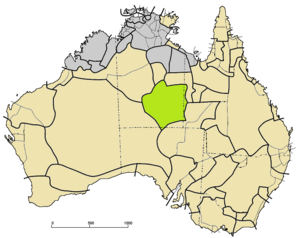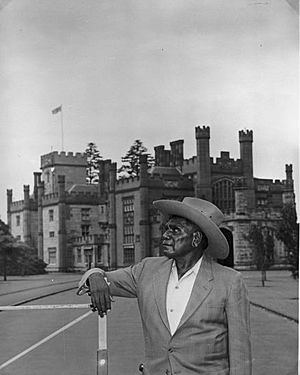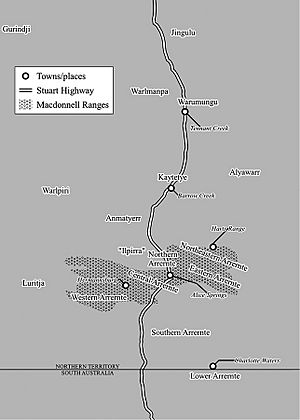Arrernte language facts for kids
Quick facts for kids Arrernte |
||||
|---|---|---|---|---|
| Arrernte | ||||
| Region | Northern Territory, Australia | |||
| Ethnicity | Arrernte people, Alyawarre, Anmatyerre, Ayerrereng, Yuruwinga | |||
| Native speakers | 4,100 (2021 census) | |||
| Language family |
Pama–Nyungan
|
|||
| Writing system | Latin | |||
| AIATSIS | C8 Arrernte, C14, C8.1 | |||

Where Arandic is spoken
|
||||

|
||||
|
||||
Arrernte (pronounced "Ah-run-da") is a group of related languages spoken by the Arrernte people in the Northern Territory, Australia. It's also known as Aranda or Upper Arrernte. There are many different ways to spell the name, like Arunta or Arrarnta. Each of the Arrernte languages also has several names.
About 1,800 people speak Eastern or Central Arrernte. This makes it one of the most widely spoken Indigenous languages in Australia. It's the one usually called "Arrernte" and is used in the Alice Springs area. You can hear it in the media, it's taught in schools and universities, and used by local government.
The second largest Arrernte language is Alyawarre. Some other Arrernte languages are spoken by very few people. People are working hard to help these languages be used more often. Sadly, some Arrernte languages are now completely extinct.
Contents
Arrernte Languages and Where They Are Spoken
The name "Aranda" is a simpler English way to say the traditional name Arrernte.
Experts group the Arrernte languages together. Some say there are five Arrernte languages plus two other related languages. Others say there are eight Arrernte languages.
Two Arrernte languages are spoken by more people than the others:
- Eastern Arrernte (also called Central Arrernte) is spoken in the Alice Springs area. In 2016, about 1,910 people spoke it. This makes it the most spoken Arrernte language and the strongest one in the group. There's a project called Apmere angkentye-kenhe that encourages people to use it.
- Alyawarra is spoken by the Alyawarre people. They live in areas like Sandover and Tennant Creek, and even parts of Queensland. In 2016, about 1,550 people spoke Alyawarra. It's considered a "Developing" language, meaning it's still strong and being used.
Sadly, most other Arrernte languages are either in danger of disappearing or have already disappeared:
- Andegerebinha (or Antekerrepenhe) was spoken east of Alice Springs. It is now extinct.
- Ayerrerenge was spoken by the Yaroinga people in the far north-east of the Arrernte area, even across the Queensland border. It is also now extinct.

- Anmatyerr (also spelled Anmatyerre) is spoken by the Anmatyerr people. It's spoken in the Mount Allan and northwest Alice Springs regions. In 2016, only 640 people spoke it, so it's considered threatened.
- Western Arrarnta (or Western Arrernte) is spoken west of Alice Springs. It is nearly extinct, with only 440 speakers in 2016.
Arrernte Sign Language
The Arrernte people also have a very special and well-developed Arrernte sign language. It is known as Iltyeme-iltyeme. This sign language allows people to communicate without speaking, which is very important in certain cultural situations.
Keeping Arrernte Languages Alive
The Northern Territory Department of Education has a plan to teach Indigenous cultures and languages. This plan helps keep Indigenous languages strong in the Northern Territory.
The Alice Springs Language Centre teaches languages in schools. They offer Arrernte, along with Indonesian, Japanese, Spanish, and Chinese.
You can also study Arrernte at university. The Batchelor Institute of Indigenous Tertiary Education and Charles Darwin University both offer courses.
Many books in Arrernte languages are available in the Living Archive of Aboriginal Languages. This helps people learn and read in these languages.
There are also projects working to bring back dying Arrernte languages, like Southern Arrernte.
How Eastern and Central Arrernte Works
Grammar Basics
Eastern and Central Arrernte has a flexible word order, meaning you can often arrange words in different ways. However, it usually follows a Subject-Object-Verb (SOV) pattern. This means the person or thing doing the action comes first, then the thing the action is done to, and finally the action itself.
The language uses special endings, called suffixes, added to words to change their meaning. For example, a suffix might show who is doing an action, where something is, or when something happened.
Pronouns
Pronouns are words like "I," "you," "he," "she," "we," and "they." In Arrernte, these pronouns change their form depending on whether they are the subject (doing the action) or the object (receiving the action). They also change based on if there are two people (dual) or many people (plural).
For example, "I" can be ayenge or the when it's the subject. But if "me" is the object, it might be ayenge or ayenhe.
Body parts are usually described in a special way in Arrernte. You don't usually say "my head" directly. Instead, you use a different type of pronoun that shows the head belongs to you in a natural way.
Common Phrases
Here are some examples of Eastern and Central Arrernte phrases:
| Arrernte | English |
|---|---|
werte
|
G'day, What's new?
|
Unte mwerre?
|
Are you alright?
|
Urreke aretyenhenge
|
See you later
|
Images for kids
See also
 In Spanish: Idioma arrernte para niños
In Spanish: Idioma arrernte para niños





